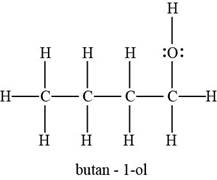
Concept explainers
To determine:
The difference between a Lewis structure and a condensed structure in terms of atoms and bonds is shown in the structure.
Introduction:
The molecules of organic compounds are represented by four different ways namely, Lewis structure, skeletal formula, condensed structural formula, and ball-and-stick model.
Lewis structures show all atoms, bonds, and lone pairs of atoms in the molecule. It helps in predicting the molecular geometry and shows the connectivity of atoms in a molecule whereas, condensed structural formula is simpler as it does not show any bonds or lone pairs of atoms and shows no connectivity of atoms in a molecule.
Explanation of Solution
The example of butanol molecule is to be assumed.
The Lewis structure of butanol molecule is represented as,

Fig.1
The number of bonds of each atom depends on the valence electrons of atoms in a molecule.
Figure 1 shows the Lewis structure in which carbon has
Condensed structure shows the shorter way to draw a molecule and is more simplified than the Lewis structure. It shows all atoms except the vertical bonds and most or all the horizontal bonds.
The condensed structure of butanol molecule is represented as,
In this formula, first carbon atom has three hydrogen atoms bonded to it; the second, third, and fourth carbon has two hydrogen atoms. The two lone pair on oxygen atoms are not shown as in condensed structure of atoms. Lone pair is not represented in the chemical symbol of atom.
Lewis structure is the most expanded structure as it shows all atoms, bonds, and lone pairs of atoms in a molecule whereas, condensed structure is the least expanded as it does not show all the bonds and lone pairs of atoms. Condensed structure is simpler than the Lewis structure.
Want to see more full solutions like this?
Chapter 4 Solutions
EBK LABORATORY MANUAL FOR GENERAL, ORGA
- Can I get helpp drawing my arrowsarrow_forwardWhich of the m/z values corresponds to the base peak in the mass spectrum shown? 100 80 A. 45 B. 44 C. 29 D. 15 Intensity 20 0 10 20 30 40 B- m/z -8 50 E. 30 Which of the m/z values correspond to the molecular ion for the compound shown? A. 18 B. 82 OH C. 100 D. 102 E. 103arrow_forwardCan someone help me with drawing my arrows.arrow_forward
- I'm having trouble with converting lewis diagrams into VSEPR diagrams. I currently have this example of C2BrCl3 which I want to turn into a lewis structure, but I'm not sure what steps I need to do in order to do so. I have the table written down, however, there's two central atoms so what would I do? There seems to be 4 electron domains on the carbon atom and no lone pairs so it would seem like this shape would be tetrahedral. Here's what I have now. Thanks!arrow_forwardWe discussed the solid phase resin using in peptide synthesis. Provide a mechanism, for its formation. DRAW THE MECHANISM.arrow_forwardPlease help. Every time I've asked an expert in the past, it's been wrong :(arrow_forward
 World of Chemistry, 3rd editionChemistryISBN:9781133109655Author:Steven S. Zumdahl, Susan L. Zumdahl, Donald J. DeCostePublisher:Brooks / Cole / Cengage Learning
World of Chemistry, 3rd editionChemistryISBN:9781133109655Author:Steven S. Zumdahl, Susan L. Zumdahl, Donald J. DeCostePublisher:Brooks / Cole / Cengage Learning World of ChemistryChemistryISBN:9780618562763Author:Steven S. ZumdahlPublisher:Houghton Mifflin College Div
World of ChemistryChemistryISBN:9780618562763Author:Steven S. ZumdahlPublisher:Houghton Mifflin College Div Chemistry: Principles and ReactionsChemistryISBN:9781305079373Author:William L. Masterton, Cecile N. HurleyPublisher:Cengage Learning
Chemistry: Principles and ReactionsChemistryISBN:9781305079373Author:William L. Masterton, Cecile N. HurleyPublisher:Cengage Learning Introductory Chemistry: A FoundationChemistryISBN:9781337399425Author:Steven S. Zumdahl, Donald J. DeCostePublisher:Cengage Learning
Introductory Chemistry: A FoundationChemistryISBN:9781337399425Author:Steven S. Zumdahl, Donald J. DeCostePublisher:Cengage Learning



